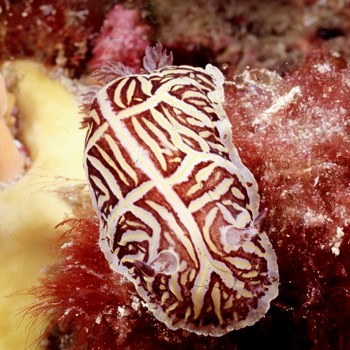
Halgerda gunnessi
Fahey & Gosliner, 2001
Order: NUDIBRANCHIA
Suborder: DORIDINA
Superfamily: EUDORIDOIDEA
Family: Dorididae
PHOTO
Halgerda gunnessi sp.nov. (WAMS 12391). Specimen, 70 mm, from Rottnest Island, Western Australia. 27 m depth, January, 1999. Photo by G. Gunness. (Fahey & Gosliner, 2001: Figure 3A.}.
This species of Halgerda has been found at depths between 27- 30 meters off Rottnest Island, Western Australia. It has yellow-crested translucent white ridges and no tubercles. The dorsum is translucent white with an overlay of chocolate brown. Between the ridges are other translucent white streaks each with a median thin yellow line. Some of these streaks connect to the ridges, others do not. The mantle edge has a white border and an inner yellow band. The foot is edged with yellow. The rhinophore club is dark brown and there appears to be as dark brown line up the anterior and posterior midlines of the stalk. The translucent white gills are quite branched and are edged in dark brown. Halgerda gunnessi is similar in colour to H. johnsonorum, but H. johnsonorum has brown spots on both the rhinophores and gills. There are also differences in the radular morphology and reproductive system of each species. It's named after Graeme Gunness, from Western Australia.
See also Halgerda theobroma which is quite similar in colour.
Reference:
• Fahey, S.J. & Gosliner, T.M. (2001) On the genus Halgerda (Nudibranchia: Halgerdidae) from Western Australia with descriptions of four new species. Bollettino Malacologico, 37(5-8): 55-76.
Rudman, W.B., 2001 (October 10) Halgerda gunnessi Fahey & Gosliner, 2001. [In] Sea Slug Forum. Australian Museum, Sydney. Available from http://www.seaslugforum.net/find/halggunn
Related messages
Re: Halgerda gunnessi from Rottnest Is, W. Australia
March 24, 2004
From: Masoud Abadi

Hi Bill,
Thanks for the identification [#12466]
Attached is the original location where the Halgerda gunnessi was. I took some artistic license and placed it some place easier and better to shoot….
Masoud Abadi.
masoud@wadiver.com
Abadi, M., 2004 (Mar 24) Re: Halgerda gunnessi from Rottnest Is, W. Australia. [Message in] Sea Slug Forum. Australian Museum, Sydney. Available from http://www.seaslugforum.net/find/12506Thanks Masoud,
I'm glad you let me know you moved it as I couldn't work out whether the object it was on was a strange sponge or a coral colony. Now I don't have to worry
Cheers
Bill Rudman
Re: Halgerda gunnessi from Rottnest Is, W. Australia
March 24, 2004
From: Adrian Baddeley
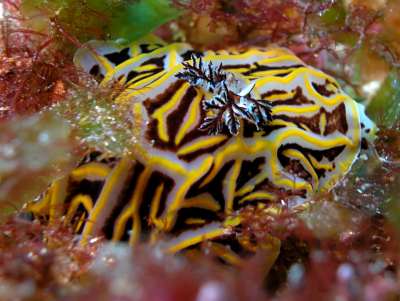
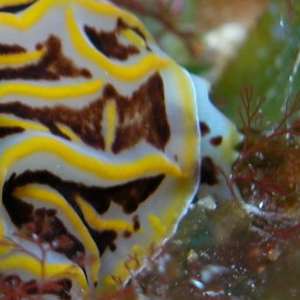
Dear Bill
Masoud asked me to send you this photo of the Halgerda gunnessi we saw together at Rottnest Island recently [message #12466]
Dive 548 was on 1 March 2004 at `Sponge Garden' which is a 30-35 m dive site off the north west end of Rottnest Island.
I don't have the GPS for that site as it was the skipper's special choice, but I'll ask him. The site is a mound of limestone reef with undulating bumps & hollows, and comparatively many sponges.
I had a quick look at the Sea Slug Forum - what a great website! I will send some separate messages with a few photos of nudibranchs that I have not been able to identify.
Kind regards
Adrian Baddeley
adrian@maths.uwa.edu.au
Baddeley, A., 2004 (Mar 24) Re: Halgerda gunnessi from Rottnest Is, W. Australia. [Message in] Sea Slug Forum. Australian Museum, Sydney. Available from http://www.seaslugforum.net/find/12507Thanks Adrian,
This is a welcome addition, as it clearly shows the edge of the mantle and the foot. I had thought from the original description and photo of this species that Halgerda gunnessi had a yellow border, but the actual wording 'The mantle margin has the same yellow coloration outlined in white' refers to the colour of the ridges so it means there is a white edge and a yellow submarginal line.
In colour therefore there is no real difference between this species and Halgerda theobroma that couldn't be considered part of a variation from many ridges to few. Both species have very similar radular morphology and both are only known from Rottnest Island. Unfortunately Fahey & Gosliner (2001) did not really discuss the possibility that the colour similarity of these two species may be intraspecific because they considered the one anatomical difference between the two - the presence of a vaginal gland in H. theobroma - to conclusively preclude a close relationship. Perhaps that is a reasonable approach, but considering the similarity between these two species I would think it would be worth investigating whether this vaginal gland develops at a certain stage in the life cycle or perhaps has a cyclical appearance?
It is certainly an interesting question. Perhaps it would be a worthwhile 'project' when visiting Rottnest in the future to keep a look out for specimens of Halgerda theobroma and H. gunnessi to see if you can find some intermediate colour forms
Best wishes
Bill Rudman
Halgerda gunnessi from Rottnest Is, W. Australia
March 17, 2004
From: Masoud Abadi
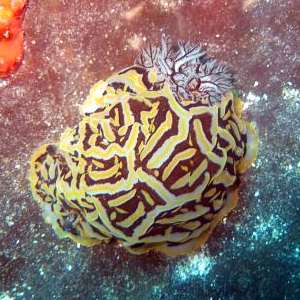
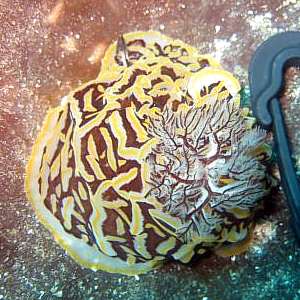
Hi Bill,
I took some photos of Halgerda graphica on the weekend [March 2004] at the west end of Rottnest Island [off Perth, Western Australia]. It looks very different from the slugs' book and your web site pics of H. graphica. Have I named it correctly?
Masoud Abadi
masoud@theinternetmen.com
Abadi, M., 2004 (Mar 17) Halgerda gunnessi from Rottnest Is, W. Australia. [Message in] Sea Slug Forum. Australian Museum, Sydney. Available from http://www.seaslugforum.net/find/12466
Dear Masoud,
This is Halgerda gunnessi. You won't find it in most identification guides because it has only been named a couple of years. I assume the sponge it is is on is where you found it. If so it might be a useful piece of information as a possible food sponge fopr the species.
Halgerda gunnessi is quite similar in appearance to H. theobroma but seems to differ in a number of colour features. Apart from the obvious differences, H. theobroma also has a white edge and a submarginal yellow line around the mantle, while in H. gunnessi the mantle edge is yellow. The foot in H. theobroma has a yellow edge. I don't know what colour the edge of the foot is in H. gunnessi. Perhaps you could check your photos and see if you have one showing the foot poking out from under the mantle somewhere.
This seems to be quite a rare species so every sighting is valuable.
Best wishes
Bill Rudman
Some information on Halgerda gunnessi
October 15, 2001
From: Shireen Fahey

Dear Bill,
Here is some information on, Halgerda gunnessi, one of the new species of Halgerda that Terry Gosliner and I have just published.
PHOTO: (WAMS 12391). Specimen, 70 mm, from Rottnest Island, Western Australia. 27 m depth, January, 1999. Photo by G. Gunness. (Fahey & Gosliner, 2001: Figure 3A}.
I've never found it hiding, but always just out in the open, on top of it's favorite sponge food, or crawling along, quite unconcerned about its bright coloration. It's named for Graeme Gunness who lives south of Perth in Western Australia and is a keen nudibranch photographer (and supporter of nudibranch researchers).
This species of Halgerda likes depths between 27- 30 meters off Rottnest Island, Western Australia. It is stunning in its coloration, with yellow-crested ridges and no tubercles. The dorsum is grayish-white with an overlay of chocolate brown. Between the ridges are other yellow lines, some which connect to the ridges. The rhinophores have dark coloration on the top half and a dark line on the posterior side from base to tip. The gill is feathery and has a dark stripe on both sides. The most similar species to Halgerda gunnessi is H. johnsonorum. But H. johnsonorum has brown spots on both the rhinophores and gills leaves. There are major differences between the radula and reproductive system of each species too.
Reference:
• Fahey, S.J. & Gosliner, T.M. (2001) On the genus Halgerda (Nudibranchia: Halgerdidae) from Western Australia with descriptions of four new species. Bollettino Malacologico, 37(5-8): 55-76.
Best wishes,
Shireen
sfahey@mailbox.uq.edu.au
Fahey, S., 2001 (Oct 15) Some information on Halgerda gunnessi. [Message in] Sea Slug Forum. Australian Museum, Sydney. Available from http://www.seaslugforum.net/find/5474Thanks Shireen,
Bill Rudman
